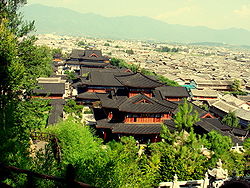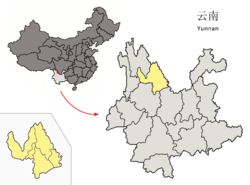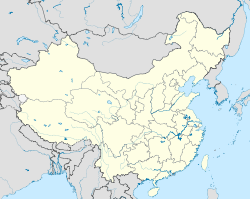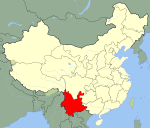- Lijiang, Yunnan
-
- For the river in Guangxi Province, see Lijiang River. Other uses see Lijiang and Old Town of Lijiang.
Lijiang
丽江— Prefecture-level city — 丽江市 Location of Lijiang City Prefecture Location within China Coordinates: 26°53′N 100°14′E / 26.883°N 100.233°E Country China Province Yunnan Admin HQ Gucheng Area – Prefecture-level city 21,219 km2 (8,192.7 sq mi) – Urban 1,127 km2 (435.1 sq mi) – Metro 1,127 km2 (435.1 sq mi) Elevation 2,400 m (7,874 ft) Population (2010 census) – Prefecture-level city 1,244,769 – Density 58.7/km2 (151.9/sq mi) – Urban 155,540 – Urban density 138/km2 (357.5/sq mi) – Metro 155,540 – Metro density 138/km2 (357.5/sq mi) Postal code 674100 Area code(s) 0888 Website http://www.lijiang.gov.cn/ Lijiang (simplified Chinese: 丽江市; traditional Chinese: 麗江市; pinyin: Lìjiāng Shì) is a prefecture-level city in the northwest of Yunnan Province, China. It has an area of 21,219 square kilometres (8,193 sq mi) and a population of 1,244,7690 as of 2010 census.
Contents
History
Lijiang City replaced former administrative region Lijiang Prefecture. Lijiang Prefecture no longer exists today. It was under the rule of the Mu family (木氏) local commanders (土司) during the Ming Dynasty and Qing Dynasty.[1]
Fictional history and literature
Lijiang or "Li-gion" is referenced and used as the ancestral home of the "Lost Legion" of Rome and of one of the main characters, Frank Zhang, in the American work of Fiction "Son of Neptune" by Rick Riordian
Administrative divisions
The government of Lijiang City sits in Gucheng District.
Lijiang City comprises one district and four counties:
Map 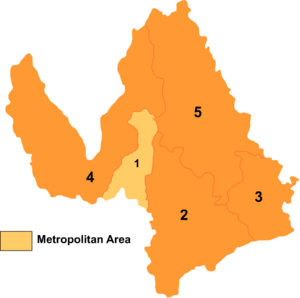
# Name Hanzi Hanyu Pinyin Population (2003 est.) Area (km²) Density (/km²) 1 Gucheng District 古城区 Gǔchéng Qū 140,000 1,127 124 2 Yongsheng County 永胜县 Yǒngshèng Xiàn 380,000 5,099 75 3 Huaping County 华坪县 Huápíng Xiàn 150,000 2,266 66 4 Yulong Nakhi Autonomous County 玉龙纳西族自治县 Yùlóng Nàxīzú Zìzhìxiàn 210,000 6,521 32 5 Ninglang Yi Autonomous County 宁蒗彝族自治县 Nínglàng Yízú Zìzhìxiàn 240,000 6,206 39 Geography
Lijiang City is located in the northwestern portion of Yunnan and borders Sichuan. It is in a region where the Qinghai-Tibet Plateau and Yunnan-Guizhou Plateau converge.
Climate
Owing to its low latitude and high elevation, the city centre of Lijiang experiences a mild subtropical highland climate (Koppen Cwb). Winters feature mild days coupled with nights that may go below freezing, as well as the driest and sunniest conditions of the year; January averages 6.0 °C (42.8 °F). Summers are warm and damp, with a June average of 18.4 °C (65.1 °F), which is much cooler than lowland areas. The annual mean temperature is 12.7 °C (54.9 °F), while precipitation averages around 970 millimetres (38 in), focused heavily from June to September.
Climate data for Lijiang, Yunnan Month Jan Feb Mar Apr May Jun Jul Aug Sep Oct Nov Dec Year Record high °C (°F) 20.7
(69.3)21.9
(71.4)25.0
(77.0)28.9
(84.0)30.6
(87.1)32.3
(90.1)31.4
(88.5)28.0
(82.4)27.3
(81.1)26.1
(79.0)23.6
(74.5)22.8
(73.0)32.3
(90.1)Average high °C (°F) 13.5
(56.3)14.7
(58.5)17.1
(62.8)20.0
(68.0)23.1
(73.6)24.0
(75.2)23.1
(73.6)22.7
(72.9)21.4
(70.5)20.0
(68.0)16.8
(62.2)14.4
(57.9)19.2 Average low °C (°F) −0.3
(31.5)2.0
(35.6)4.8
(40.6)7.8
(46.0)11.2
(52.2)14.3
(57.7)14.5
(58.1)13.6
(56.5)12.2
(54.0)8.7
(47.7)3.5
(38.3)−0.1
(31.8)7.7 Record low °C (°F) −7
(19)−6
(21)−4
(25)−1.3
(29.7)3.5
(38.3)6.2
(43.2)6.9
(44.4)6.6
(43.9)4.4
(39.9)0.9
(33.6)−4.5
(23.9)−10.3
(13.5)−10.3
(13.5)Precipitation mm (inches) 2.3
(0.091)5.8
(0.228)16.7
(0.657)21.0
(0.827)55.8
(2.197)167.3
(6.587)242.2
(9.535)206.3
(8.122)160.8
(6.331)70.0
(2.756)16.0
(0.63)3.8
(0.15)968
(38.11)% humidity 46 46 49 54 59 73 81 83 83 73 62 53 63.5 Avg. precipitation days (≥ 0.1 mm) 1.9 3.9 6.6 7.9 11.7 20.3 24.2 22.3 20.8 11.5 4.3 1.5 136.9 Sunshine hours 259.9 229.7 248.4 233.4 225.1 156.7 134.2 155.0 138.8 195.2 226.6 260.3 2,463.3 Source no. 1: Weather China[2] Source no. 2: China Meteorological Administration (sunshine and humidity, 1971–2000) [3] Transport
- Lijiang Airport (LJG); Lijiang Airport is located in the south of Lijiang city, 28 km away from downtown. There is an airport shuttle bus service in downtown Lijiang. The airport was opened in July 1995 and has flights to Kunming, Chengdu, Xishuangbanna, Beijing, Shanghai, Guangzhou, Shenzhen, Xiamen via Chongqing and Guiyang. It also offers chartered airplane service. There are flights from Kunming to Lijiang every day and is about 30 minutes flight time.
- There are bus services to, amongst others, Kunming City (8 hrs), Dali City (3 hrs), the Tiger Leaping Gorge and Shangri-La.
- There is a train service to Kunming with one overnight and two day trains, and one day train to Dali.
The Baisha Hand-made Embroidery Institute
Nearby Lijiang is the Baishui Terrace Baishuitai (白水台, literally "White Water Terrace") is an area where spring water flows over a sinter terrace, leaving behind travertine.
The world famous Old Town of Lijiang is located in Lijiang City. It is a UNESCO Heritage Site.
The town has a history going back more than 800 years and was once a confluence for trade along the old tea horse road. The Lijiang old town is famous for its orderly system of waterways and bridges. The old town of Lijiang differs from other ancient Chinese cities in architecture, history and the culture of its traditional residents the Nakhi people, therefore people there are called 胖金哥 and 胖金妹 (pàng jīn gē, pàng jīn mèi, male and female respectively).
There are three old towns in Lijiang , Dayuan Old Town, Shuhe Old Town and Baisha Old Town. The three old towns were listed as the World Cultural Heritage by Unesco in the year 1997.Among the three towns, Dayuan Old Town and Suhe Old Town have been spoiled a lot by tourists in recent years,so they are touristic and commercialized, but the Baisha Old Town is very genuine, nice ,simple and attractive. This Town is famous for The Baisha Fresco and The Naxi Hand-made Embroidery Institute.The Fresco was made in the Ming Dynasty 600 years ago, the Naxi Hand-made Embroidery Institute was built 800 years ago, it is the head quarter of the Naxi embroideries and also ,it is like a school for the Naxi embroiderers. There are many Naxi embroidery masters, teachers, students and local farmers there. They are very nice and friendly, meanwhile,many gorgeous and unbelievable embroidery arts can be found there.It is a very special place.
The Baisha Old Town use to be the political, commercial and cultural center for the local Naxi people and other ethnic people for 400 years from the year 658 AD to 1107 AD. The Dabaoji Palace of the Baisha Fresco where is very close to the Baisha Naxi Hand-made Embroidery Institute was built in the year 658AD in the Tang Dynasty (618 AD to 960 AD).
The Baisha Old Town use to be the center of silk embroidery in the southwest of China and the most important place of the Ancient Southern Silk Road ,also called the Ancient Tea and Horse Road. The Ancient Southern Silk Road started from Myanmar, crossed Lijiang, Shangeri-la, Tibet, Iran, Israel after the Mediterranean Sea eventually got to France, Italy, Spain, Germany, England, Switzerland and other European countries and African countries.It Played an very important role for trade and cultural exchange between different regions and countries.
The Naxi women were well-known for their hand-made embroidery before the year 1972 during the Great Cultural Revolution.The most famous Naxi masters were arrested and put in the jail, some of them were died in the jail during the Cultural Revolution because they did hand-made embroidery only for the Naxi Emperors when they were young.
Sister Cities
- Kazan, Tatarstan,
 Russia [4]
Russia [4] - Roanoke, Virginia,
 United States
United States - New Westminster, British Columbia,
 Canada
Canada - Takayama, Gifu,
 Japan[citation needed]
Japan[citation needed]
See also
- Riding Alone for Thousands of Miles: a film by Zhang Yimou which takes place in the Lijiang area
References
- ^ 丽江木氏土司与滇川藏交角区域历史文化研讨会综述[dead link]
- ^ "丽江城市介绍" (in Simplified Chinese). Weather China. Nomvember 2011. http://www.weather.com.cn/cityintro/101291401.shtml. Retrieved 2011-11-14.
- ^ "中国地面国际交换站气候标准值月值数据集(1971-2000年)" (in Simplified Chinese). China Meteorological Administration. May 2011. http://cdc.cma.gov.cn/shuju/search1.jsp?dsid=SURF_CLI_CHN_MUL_MMON_19712000_CES&tpcat=SURF&type=table&pageid=3. Retrieved 2010−06−04.
- ^ Successful use of heritage is the pledge of prosperous future of Euro-Asia Cities (DOC file). II International Conference of World Heritage Cities of Euro-Asia. Lijiang. 15–18 October 2006
External links
Listen to this article (info/dl)
This audio file was created from a revision of Lijiang, Yunnan dated 2007-01-15, and does not reflect subsequent edits to the article. (Audio help)More spoken articlesCoordinates: 26°53′N 100°14′E / 26.883°N 100.233°E
Yunnan topics General Geography Cities • Yunnan-Guizhou Plateau • Diqing Plateau • Honghe River • Dianchi Lake • Fuxian Lake • Erhai Lake • Lugu Lake • Yangzong Lake • Yilong Lake • Xi River • Yuan River • Pearl River • Red River • Pudacuo National ParkEducation Culture Music • Eighteen OdditiesCuisine Visitor attractions World Heritage Sites in China East Classical Gardens of Suzhou · Fujian Tulou · Lushan National Park · Mount Huang (Huangshan) · Mount Sanqing (Sanqingshan) · Mount Tai (Taishan) · Mount Wuyi (Wuyishan) · Temple and Cemetery of Confucius and Kong Family Mansion, Qufu · Ancient villages in Southern Anhui - Xidi and Hongcun · West Lake Cultural Landscape of Hangzhou
South Central Ancient Building Complex in the Wudang Mountains · Historic Centre of Macau · Kaiping Diaolou and Villages · Longmen Grottoes · Historic Monuments of Dengfeng, including the Shaolin Monastery and Gaocheng Observatory · Wulingyuan Scenic and Historic Interest Area · Yin Xu
Southwest Dazu Rock Carvings · Historic Ensemble of the Potala Palace, including the Jokhang and Norbulingka · Huanglong Scenic and Historic Interest Area · Jiuzhaigou Valley Scenic and Historic Interest Area · Old Town of Lijiang · Mount Emei Scenic Area, including Leshan Giant Buddha Scenic Area · Mount Qingcheng and the Dujiangyan Irrigation System · Sichuan Giant Panda Sanctuaries · Three Parallel Rivers of Yunnan Protected Areas
North Mount Wutai (Wutaishan) · Chengde Mountain Resort and its outlying temples including the Putuo Zongcheng Temple, Xumi Fushou Temple and the Puning Temple · Imperial Palaces of the Ming and Qing Dynasties in Beijing and Shenyang · Peking Man Site at Zhoukoudian · Ancient City of Pingyao · Summer Palace, an Imperial Garden in Beijing · Temple of Heaven: an Imperial Sacrificial Altar in Beijing · Yungang Grottoes
Northeast Capital Cities and Tombs of the Ancient Koguryo Kingdom · Imperial Palaces of the Ming and Qing Dynasties in Beijing and Shenyang
Northwest Multiple regions Categories:
Wikimedia Foundation. 2010.

